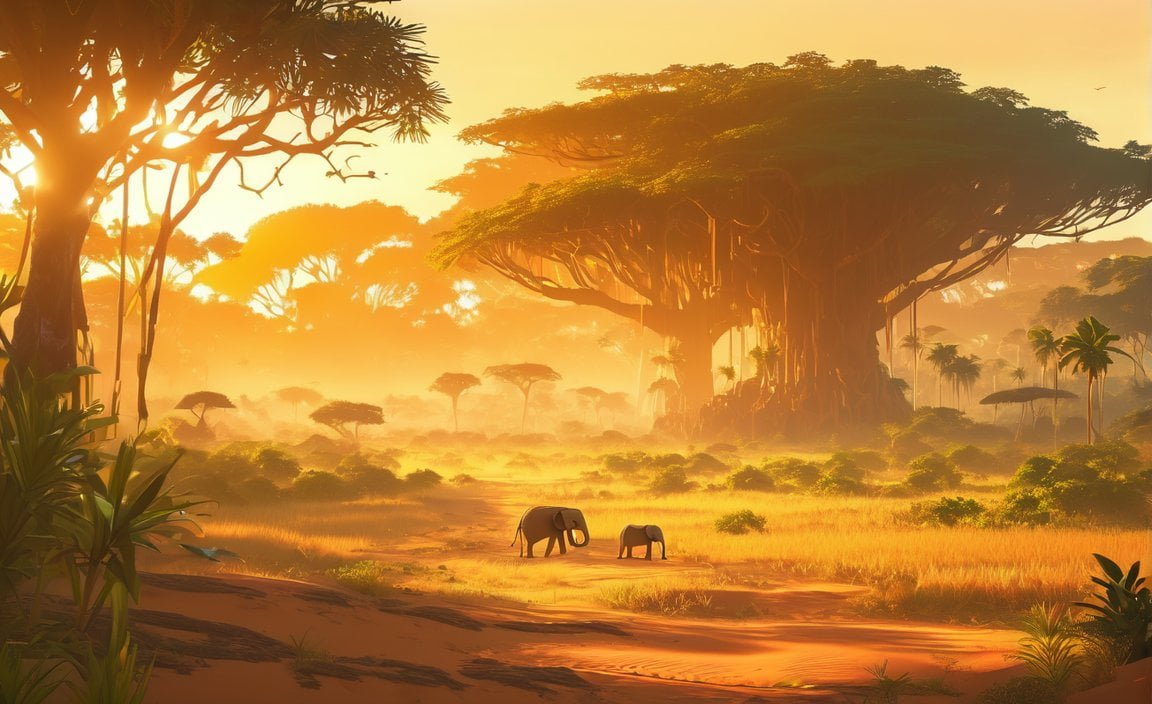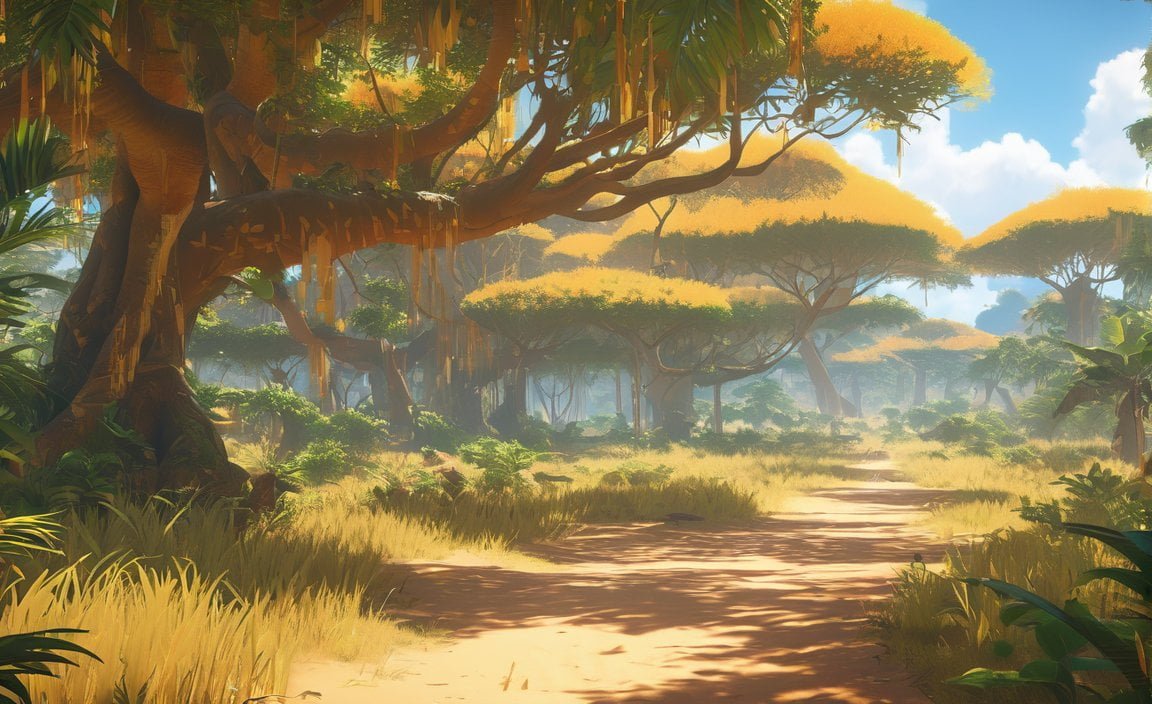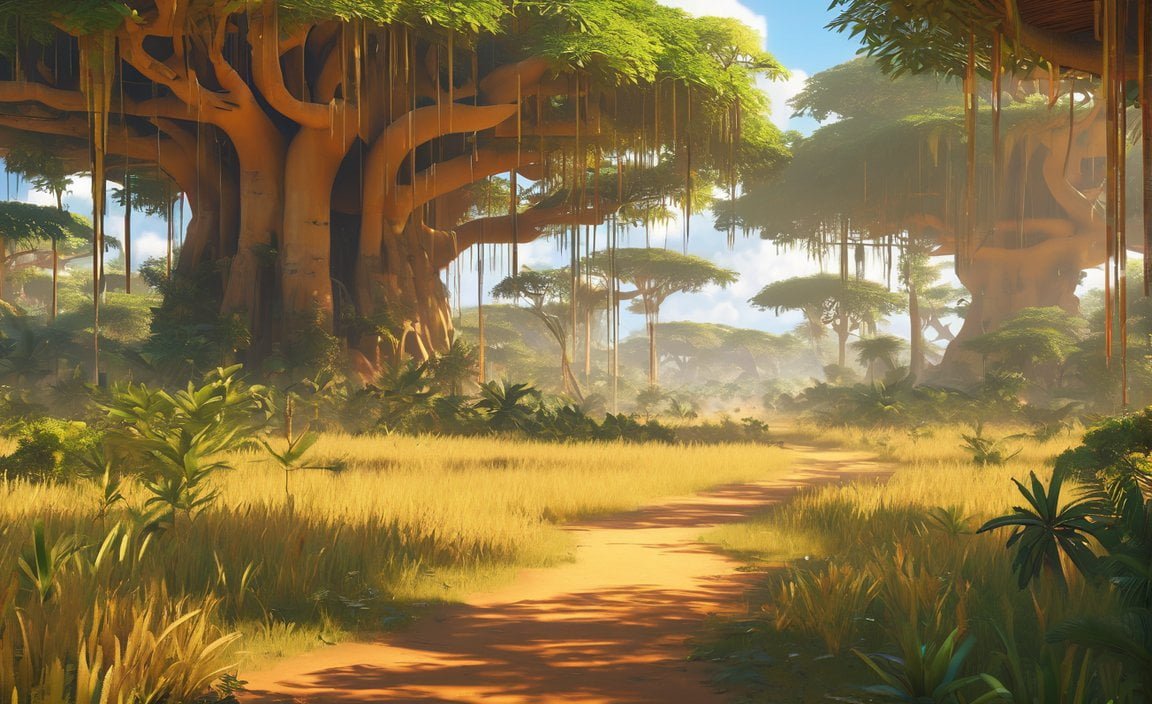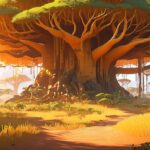Unveiling the Hidden Wonders: 10 Facts About Tropical Savannas

Prepare to embark on a thrilling journey through the remarkable world of tropical savannas, as we unveil ten mesmerizing facts about these astonishing ecosystems. With its vast expanses of grasslands and diverse array of wildlife, the tropical savanna has long captured the imaginations of both nature enthusiasts and scientists alike. Join us as we delve into this captivating landscape, shedding light on its hidden wonders and revealing the intricate marvels that make the tropical savanna a truly awe-inspiring realm.
Key Takeaways:
- Fires on grasslands can spread at a rapid rate of 600 ft per minute.
- Lions can grow up to 10 feet in length, while giraffes are the tallest animals in the world, reaching heights of 20 feet.
- The cheetah holds the title for the fastest land animal, capable of reaching speeds of 70 miles per hour.
- Tropical savannas, covering half of Africa, are primarily open spaces with scattered trees and brush.
- A diverse range of wildlife, including elephants, lions, and giraffes, can be found in savannas.
- Savannahs experience seasonal rains and dry periods, with all plant and tree species being able to survive droughts.
- Savannahs have a consistent hot climate throughout the year, characterized by wet and dry seasons.
- Fires, often caused by lightning, are common in savannas and play a vital role in their growth.
- Baobab trees, known for their large trunks, are a prominent feature of savannah ecosystems.
10 Facts About the Tropical Savanna
The tropical savanna is a captivating ecosystem that teems with diverse wildlife and fascinating natural phenomena. From lightning-sparked fires to towering giraffes, here are 10 intriguing facts that unveil the hidden wonders of the tropical savanna:
1. Fires on grasslands can move as quickly as 600 ft per minute[^1^].
In the tropical savanna, fires play a vital role in maintaining the delicate balance of this ecosystem. These fires, often started by lightning, can spread rapidly, consuming dry grasses and underbrush. Despite their destructive nature, these fires also stimulate new plant growth and clear the way for young trees to thrive.
2. Lions can grow up to 10 feet in length[^1^].
The regal lions that roam the savanna are not only a symbol of strength and power but also impressively large creatures. These majestic predators can reach lengths of up to 10 feet, making them the second-largest big cat species in the world.
3. Giraffes are the tallest animals in the world, growing up to 20 feet tall[^1^].
One cannot overlook the serene giants of the savanna – the giraffes. These graceful creatures possess the incredible ability to reach heights of up to 20 feet, allowing them to browse on leaves at towering heights that other animals cannot reach.
4. The cheetah is the fastest land animal and can run in bursts of 70 miles per hour to catch its prey[^1^].
When it comes to speed, the cheetah reigns supreme. This sleek and agile predator can accelerate from 0 to 60 miles per hour in just a few seconds, reaching bursts of up to 70 miles per hour. Their incredible speed allows them to chase down and capture their prey with astonishing precision.
5. Savannahs are tropical grasslands that cover half of Africa[^2^].
Spanning vast stretches of land across Africa, tropical savannas are a dominant landscape that covers approximately half of the continent. These grasslands are characterized by tall grasses, scattered trees, and a diverse array of wildlife uniquely adapted to this challenging environment.
6. Savannahs are mostly open spaces, but in some places, they are scattered with trees and brush[^2^].
While the savanna’s open expanse is a defining feature, it is not devoid of vegetation. In some areas, the grasses give way to scattered trees and shrubs, providing essential shade and shelter for the countless species that call this ecosystem home.
7. Savannahs support many different kinds of animals, such as elephants, lions, and giraffes[^4^].
The tropical savanna is a thriving hub of biodiversity. From the majestic African elephants that graze upon the grasses, to the powerful lions that command the savanna’s apex, and the towering giraffes that gracefully navigate its open plains, the savanna is home to an impressive variety of wildlife.
8. Savannahs have seasonal rains and dry periods, and all savanna plants and trees can survive periods of drought[^5^].
The tropical savanna experiences distinct wet and dry seasons, with periodic rainfall followed by extended droughts. The native plants and trees of the savanna have adapted to survive these challenging conditions. They possess specialized root systems and drought-resistant features that enable them to thrive even during prolonged periods of little to no rainfall.
9. Savannahs are hot year-round, with a wet and dry season[^4^].
Exploring the tropical savanna means embracing the heat. These grasslands are characterized by a year-round warm climate, with temperatures often soaring under the fiery African sun. The alternating wet and dry seasons bring significant variations in rainfall patterns, further shaping the dynamic nature of the savanna ecosystem.
10. Fires, often from lightning, are common in savannas and help with growth[^4^].
In the tropical savanna, fires are not only an occasional occurrence but an essential element for its vitality. These fires, most commonly ignited by lightning strikes, contribute to the renewal of the ecosystem. By clearing away old vegetation and promoting the growth of nutrient-rich new plants, these fires play a crucial role in maintaining the savanna’s ecological balance.
Further Reading
For more in-depth information on tropical savannas and their characteristics, you may find the following sources helpful:
By delving into these resources, you can explore the vibrant world of the tropical savanna and uncover even more intriguing insights about this captivating ecosystem.
References:
[^1^]: Tropical Grassland/Savanna – Fun Facts. Retrieved from
[^2^]: African Savannas – Facts for Now. Retrieved from https://factsfornow.scholastic.com/article?product_id=nbk&type=0ta&CPSIAHIDDEN=recouycg0zatjva53pkyr9qr8
Check out these 10 fascinating facts about biomes. You’ll discover amazing information about the different types of environments on Earth! 10 facts about biomes
Get ready to be amazed by these 10 mind-blowing facts about condensation. Learn about the incredible process that turns water vapor into tiny droplets! 10 facts about condensation
Explore the captivating world of marine biology with these 10 incredible facts. From marine creatures to ecosystems, prepare to be awestruck! 10 facts about marine biology
Dive deep into the wonders of marine life with these 10 mesmerizing facts. Discover the beauty and diversity of the creatures that inhabit our oceans! 10 facts about marine life
Embark on a journey to uncover the secrets of ocean life with these 10 astonishing facts. From mysterious creatures to vast ecosystems, prepare to be amazed! 10 facts about ocean life
Discover the enchanting world of temperate deciduous forests with these 10 fascinating facts. From changing seasons to unique plant and animal adaptations, prepare to be captivated! 10 facts about temperate deciduous forest
Uncover the wonders of temperate forests with these 10 captivating facts. Learn about the diverse ecosystems and fascinating creatures that thrive in these regions! 10 facts about temperate forests
Step into the incredible realm of temperate rainforests with these 10 mind-boggling facts. Explore the lush landscapes and extraordinary biodiversity found within these unique habitats! 10 facts about temperate rainforest
Experience the awe-inspiring beauty of the African savanna with these 10 extraordinary facts. Discover the amazing wildlife and vast landscapes that make this ecosystem so remarkable! 10 facts about the African savanna
Dive into the mesmerizing world of marine life with these 10 astonishing facts. From majestic whales to vibrant coral reefs, prepare to be awe-struck! 10 facts about the marine life
Plunge into the depths of the ocean and uncover these 10 fascinating facts about ocean animals. From bizarre creatures to incredible adaptations, prepare to be amazed! 10 facts about the ocean animals
Fact about the tropical savanna 3: Unique plant adaptations for surviving the harsh environment
Discovering the Remarkable Survival Strategies of Plants in the Tropical Savanna
The tropical savanna is a captivating ecosystem teeming with unique plant life. In this article, we delve into the fascinating world of plant adaptations within this harsh environment. Brace yourself for a riveting journey through the intricate mechanisms that enable plants to survive and thrive. Here are 10 lesser-known facts about the extraordinary plant adaptations found in the tropical savanna.
Key Takeaways:
- Plants in the tropical savanna have developed a range of adaptations to endure the challenging conditions of this ecosystem.
- Unique strategies such as long taproots, drought-tolerant leaves, and fire resistance help plants survive in the savanna.
- These adaptations allow plants to access water, withstand droughts, and protect themselves against grazing animals and wildfires.
- Understanding these remarkable plant adaptations helps us appreciate the delicate balance of life within the tropical savanna.
1. Deep Roots: Tapping into Survival
One of the most remarkable adaptions of savanna plants is their ability to grow deep roots in search of water sources. These extensive root systems allow plants to access water even during extended dry periods. By reaching deep beneath the surface, plants can tap into hidden reserves, ensuring their survival in the face of drought. This unique adaptation not only aids plants in acquiring essential water but also provides protection against fires.
2. Thick Bark: A Protective Shield
In response to the frequent wildfires that sweep through the savanna, many plants have evolved thick bark as a defense mechanism. This adaptation acts as a protective shield, safeguarding the plant’s vital tissues from the intense heat and flames. Thick bark also aids in conserving moisture during dry spells, enabling plants to withstand prolonged periods without water.
3. Drought-Tolerant Leaves: Surviving the Arid Spell
To combat the arid conditions of the savanna, plants have developed leaves with specialized adaptations. These adaptations minimize water loss, allowing plants to survive extended periods without rainfall. Some species sport narrow, needle-like leaves that reduce surface area, while others have developed thick cuticles to prevent water evaporation. By conserving precious water resources, plants can endure the long dry seasons.
4. Fire-Adapted Reproduction: Seizing Opportunities
Fire is both a destructive force and a catalyst for growth in the savanna. Some plants have harnessed the power of fire to ensure their survival. They have evolved adaptations that facilitate seed germination and rapid growth immediately after a fire. By taking advantage of the nutrient-rich ashes and reduced competition, these plants seize the opportunity to flourish, successfully reproducing and replenishing the savanna.
5. Serpentine Adaptations: Thriving in Harsh Soils
The tropical savanna is known for its nutrient-poor and highly acidic soils. However, some plants have evolved unique adaptations to thrive in these challenging environments. Serpentine adaptations, as they are called, involve specialized root structures and metabolic processes that enable plants to efficiently absorb and store limited nutrients. These remarkable adaptations allow certain plant species to flourish where others struggle to survive.
6. Wind-Dispersed Seeds: Embracing Change
In the ever-changing landscape of the savanna, plants have devised ingenious ways to disperse their seeds. Many savanna plants produce lightweight seeds with structures that aid in wind dispersal. These seeds, often with wing-like appendages or fine hairs, catch the breeze and travel vast distances. By embracing change and dispersing their seeds, these plants ensure the survival of their species, even in the face of shifting conditions.
7. Sun-Tolerant Adaptations: Basking in the Light
The tropical savanna is renowned for its ample sunlight, which poses unique challenges for plants. To cope with excessive solar radiation, some plants have developed sun-tolerant adaptations. These adaptations include waxy coatings on leaves to reduce water loss, specialized pigments to protect against ultraviolet rays, and mechanisms for redirecting light to optimize photosynthesis. With these adaptations, plants can harness the energy of the sun while minimizing the risk of damage.
8. Mutualistic Relationships: Cooperating for Survival
In the intricate web of life within the savanna, plants often engage in mutualistic relationships for their survival. Certain plants form symbiotic partnerships with fungi, which help enhance nutrient absorption from the soil. Others establish mutually beneficial relationships with specialized bacteria that assist in nitrogen fixation. These partnerships exemplify the interconnectedness of life in the savanna and the remarkable adaptations that arise from cooperation.
9. Reproductive Timing: Synchronizing Success
Plants in the tropical savanna have finely tuned their reproductive timing to align with favorable environmental conditions. By synchronizing flowering and seed production with the onset of the rainy season, plants optimize their chances of successful reproduction. This careful coordination ensures that seeds have the best possible conditions for germination and survival, giving rise to the next generation of plant life in the savanna.
10. Resilient Regrowth: Bouncing Back from the Brink
In the face of grazing by herbivores, savanna plants possess a remarkable ability to regenerate and bounce back. Many species have evolved adaptations allowing them to rapidly regrow foliage and shoots after being grazed. By quickly recovering from herbivory, these plants can persist in the harsh savanna environment and continue to play their vital roles in the ecosystem.
As we unravel the wonders of plant adaptations in the tropical savanna, it becomes evident that these incredible mechanisms enable plants to flourish against all odds. Each adaptation tells a story of resilience, cooperation, and survival. From deep roots to fire-adapted reproduction, these plants have honed their strategies over time to overcome the challenges of their harsh environment. Now, it’s up to us to protect and preserve this delicate balance of life in the hidden wonders of the tropical savanna.
Sources:
– Ask A Biologist. (n.d.). “Plants Need Water.” Retrieved from Ask A Biologist.
– Biology LibreTexts. (n.d.). “Savanna.” Retrieved from Biology LibreTexts.
Fact about the tropical savanna 4: Migration patterns of animals in search of water and food
Key Takeaways:
- Migration is a common phenomenon among animals in tropical savannas as they search for water and food.
- The migration patterns of animals in the savanna are influenced by seasonal changes, availability of resources, and the need to avoid harsh conditions.
- Wildebeests, zebras, and gazelles are iconic migratory animals in the savanna, known for their impressive long-distance journeys.
- These migratory animals undertake treacherous journeys guided by an innate sense of direction, landmark recognition, and collective behavior.
- The migration of these animals not only ensures their survival but also plays a crucial role in shaping the savanna ecosystem.
- The migration of herbivores in search of water and food attracts predators, creating a cycle of life and death in the savanna.
- Key factors that trigger migration include the depletion of food and water sources, changing weather patterns, and the need for breeding opportunities.
- The migration route of animals in the savanna is a result of generations of learned behavior and adaptation to the ever-changing landscape.
- The migration patterns of animals in the savanna showcase the remarkable resilience and adaptability of wildlife in the face of environmental challenges.
- Studying the migration patterns of animals in the savanna provides valuable insights into the interdependence and intricate web of life within this ecosystem.
Migration is a fascinating phenomenon in the tropical savanna, driven by the instinctive need for animals to find water and food. Throughout the year, these vibrant grasslands witness the impressive journeys of various species in search of abundant resources, and the migration patterns of animals in the savanna are a testament to their remarkable adaptability and survival strategies.
One of the most iconic migrations in the savanna is undertaken by wildebeests, zebras, and gazelles. Every year, these animals embark on long and treacherous journeys, covering vast distances in search of greener pastures and fresh water sources. Guided by an innate sense of direction, landmark recognition, and collective behavior, they navigate through challenging terrain, including rivers teeming with crocodiles and prides of hungry lions lurking in the grass.
The migration of herbivores in the savanna not only ensures their survival but also shapes the ecosystem. As these animals move, they create trails and paths that lead to a constant cycle of life and death. The presence of herds of migratory herbivores attracts predators like lions, who rely on the abundance of prey during these migrations. This interdependence highlights the delicate balance of the savanna ecosystem.
Migration in the savanna is triggered by various factors, including the depletion of food and water sources, changing weather patterns, and the need for breeding opportunities. As resources become scarce in certain areas, animals instinctively set off in search of more favorable conditions. They follow specific migration routes that have been passed down through generations, a result of learned behavior and adaptation to the ever-changing landscape.
The migration patterns of animals in the savanna reveal their resilience and adaptability in the face of environmental challenges. These remarkable journeys demonstrate the intricate web of life within the ecosystem and the interdependence of species. Studying and understanding these patterns provide valuable insights into the dynamics and conservation of the savanna.
Sources:
- African Wildlife Foundation – The Great Migration
- National Geographic – Treks Across the Serengeti
Fact about the tropical savanna 5: Coexistence of predator and prey species and their interdependence
The coexistence of predator and prey species is a fascinating aspect of the tropical savanna ecosystem. In these expansive grasslands, a delicate balance exists between predators and their prey, with intricate interdependencies at play.
Predator-Prey Dynamics: The tropical savanna is teeming with diverse predator and prey species, each playing a crucial role in maintaining the ecosystem’s equilibrium. The interaction between predators and their prey is a key driver of population dynamics and shapes the distribution and behavior of species.
Intertwined Lives: Predators and prey are intricately linked in a dance of survival. The presence of predators exerts selective pressure on prey species, driving them to evolve various adaptations to escape predation. This, in turn, fuels the evolution of predators, as they develop enhanced hunting techniques to catch their prey.
Spatial Interactions: The spatial distribution of predators and prey in the tropical savanna is not random. Research conducted in Baluran National Park, East Java, Indonesia, utilized advanced techniques such as digital camera traps to study the spatial and temporal activities of predators and prey. The analysis revealed distinct spatial interactions between species, highlighting specific areas where predator-prey interactions are concentrated.
Temporal Overlap: Daily activity overlap between predator and prey species also plays a significant role in their coexistence. Quantifying overlap patterns provides insights into the intensity of interactions and the potential for predation. Coefficient of overlap analysis helps measure the degree of temporal overlap, shedding light on the intricate timetables of these species.
Balancing Act: The coexistence of predator and prey species in the tropical savanna is a delicate balancing act. Predators require a consistent supply of prey for sustenance, while prey species must avoid falling prey to predators. This dance of survival creates a harmonious web of life, where each participant is crucial for the ecosystem’s overall health.
Facilitating Coexistence: Habitat structure and refugia within the tropical savanna provide opportunities for predator and prey species to coexist. These features offer hiding places for prey, while also providing predators with optimal locations for ambushing their targets. The availability of refugia contributes to the delicate balance between predator and prey populations.
Evolutionary Significance: The interdependence of predator and prey species in the tropical savanna is not only vital for maintaining ecological balance but also has broader evolutionary implications. Through the never-ending arms race between predators and prey, these species have driven each other’s evolution, leading to the diversification of traits and strategies for survival.
Supportive Ecosystem: The tropical savanna ecosystem offers a diverse array of resources for both predators and prey. From abundant vegetation providing camouflage for prey species to open spaces facilitating efficient hunting for predators, the ecosystem plays a pivotal role in fostering predator-prey interdependence.
Critical Research: Studies conducted in the Baluran National Park region have shed light on predator-prey interactions in tropical savannas. By utilizing innovative research methodologies, scientists have unraveled the complex relationships between species, contributing to our understanding of how predator and prey coexist in these fascinating ecosystems.
Conservation Implications: Understanding the coexistence of predator and prey species in the tropical savanna is vital for conservation efforts. By recognizing the delicate balance between these populations, conservationists can develop strategies to protect both predators and their prey. Conservation initiatives can focus on maintaining habitat structure, preserving refugia, and promoting sustainable management practices to safeguard the interdependence of these species.
Key Takeaways:
- The tropical savanna is home to diverse predator and prey species, engaging in a delicate dance of survival.
- The spatial and temporal interactions between predators and prey shape the dynamics of the ecosystem.
- Habitat structure and refugia facilitate the coexistence of these species.
- Predators and prey drive each other’s evolution through an ongoing arms race.
- Understanding predator-prey relationships is crucial for conservation efforts in the tropical savanna.
Sources:
1. Spatiotemporal inter-predator and predator–prey interactions of …
2. Savanna – Grassland, Climate, Animals | Britannica

FAQ
Q1: What are some interesting facts about tropical savannas?
A1: Tropical savannas are home to a diverse range of wildlife, including animals like lions, giraffes, and elephants. They often experience seasonal rains and dry periods, and fires are common occurrences that actually help with the growth of the grasslands.
Q2: How fast can fires move in tropical savannas?
A2: Fires in tropical savannas can move as quickly as 600 feet per minute. This rapid spread of fire is due to the dry and grassy nature of the savanna ecosystem.
Q3: What is the significance of baobab trees in tropical savannas?
A3: Baobab trees are commonly found in tropical savannas and their large trunks serve as an important part of the savanna ecosystem. These trees provide shelter and habitat for various animals, as well as serve as a source of food and water during dry periods.
Q4: How do plants in tropical savannas survive during periods of drought?
A4: Plants in tropical savannas have adaptations that allow them to survive during periods of drought. Many plants have deep roots that can access water deep in the ground. These roots also help plants survive fires by protecting the vital water source.
Q5: What are the unique characteristics of the savanna ecosystem?
A5: The savanna ecosystem is characterized by its open grasslands with scattered trees and shrubs. It covers about half of Africa and supports a wide variety of wildlife, including some of the tallest animals on Earth, such as giraffes.
- Star Ring Trends: Etsy vs Amazon - March 28, 2025
- Boost Pollinator Habitats: Baby Blue Eyes Sustainable Farming Guide - March 28, 2025
- Protect Big Black Bears: Effective Conservation Strategies - March 28, 2025
















